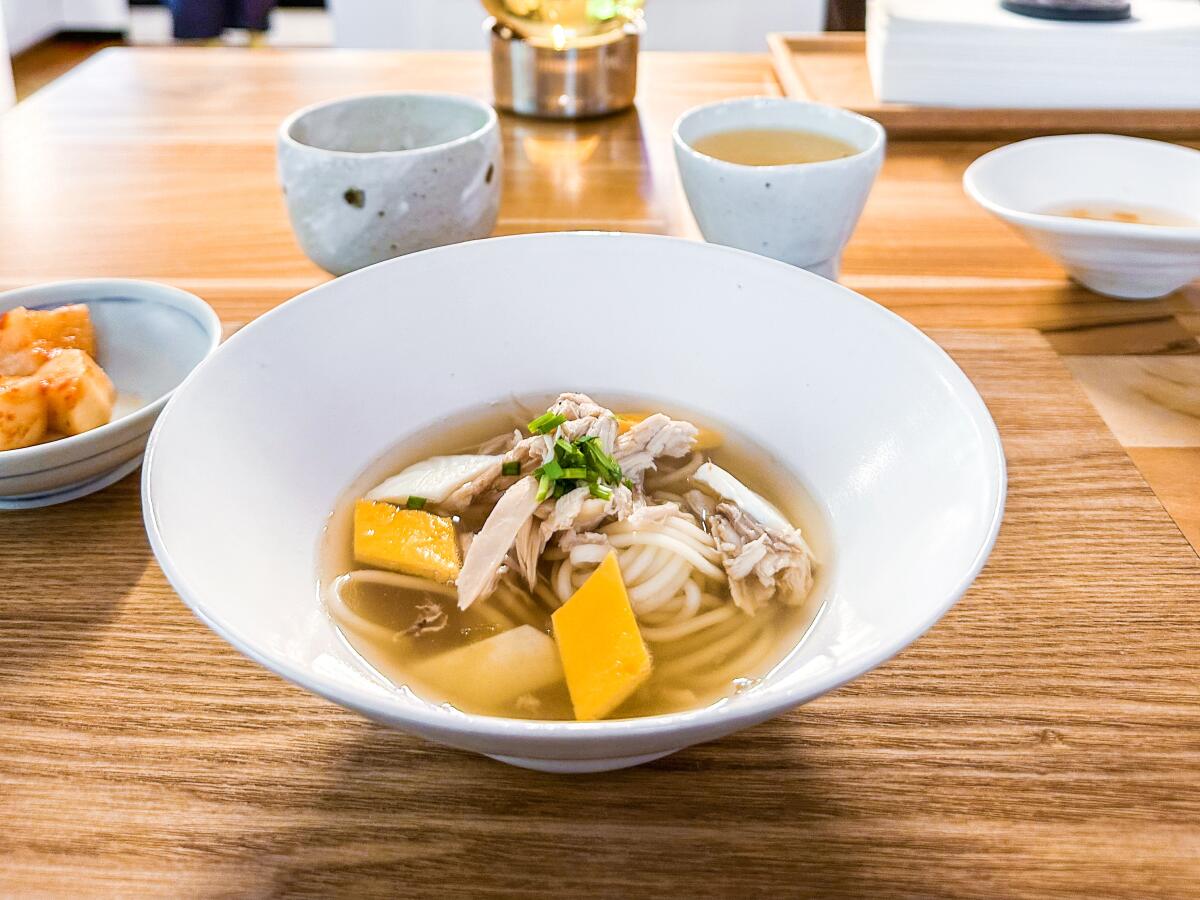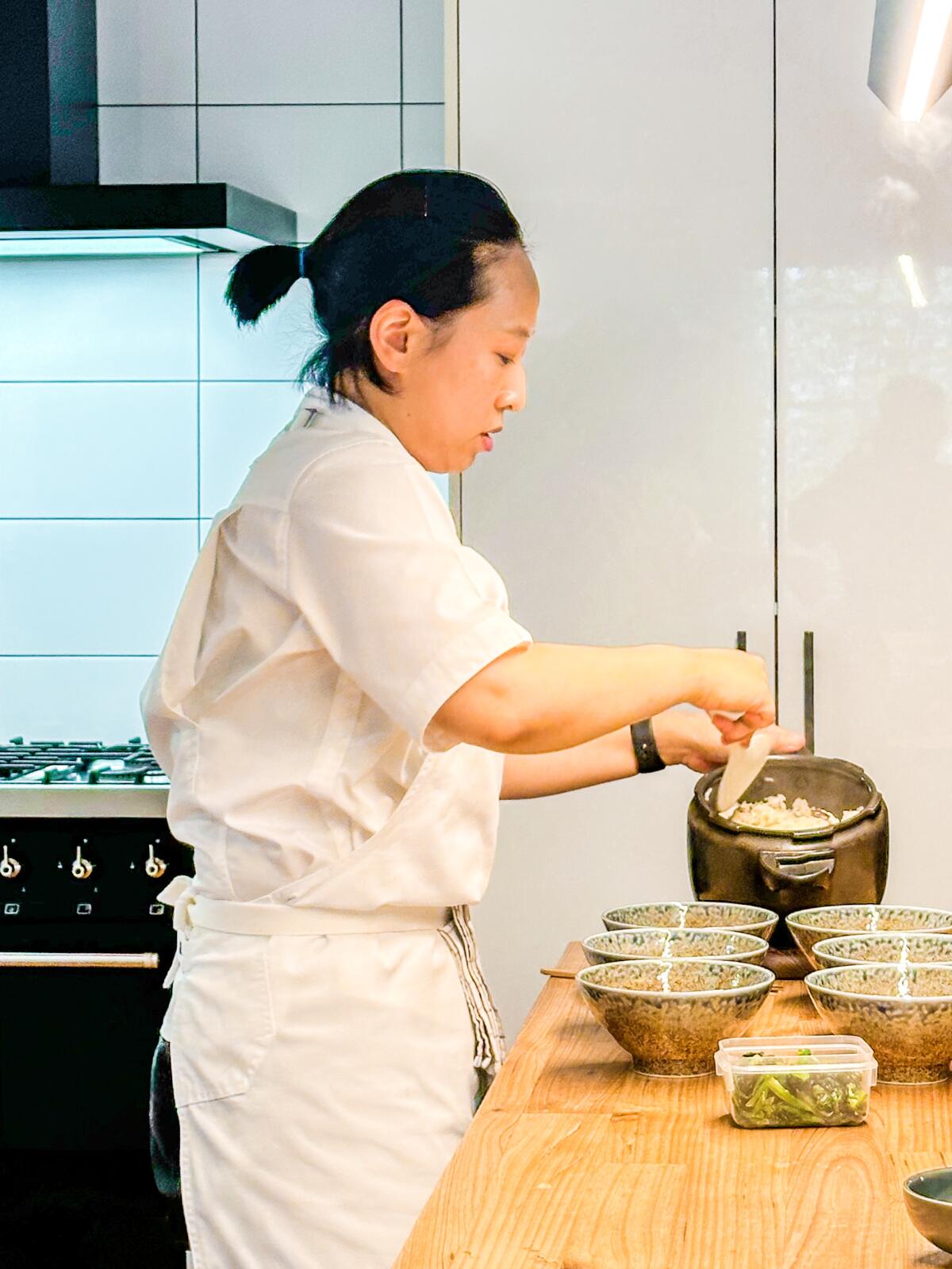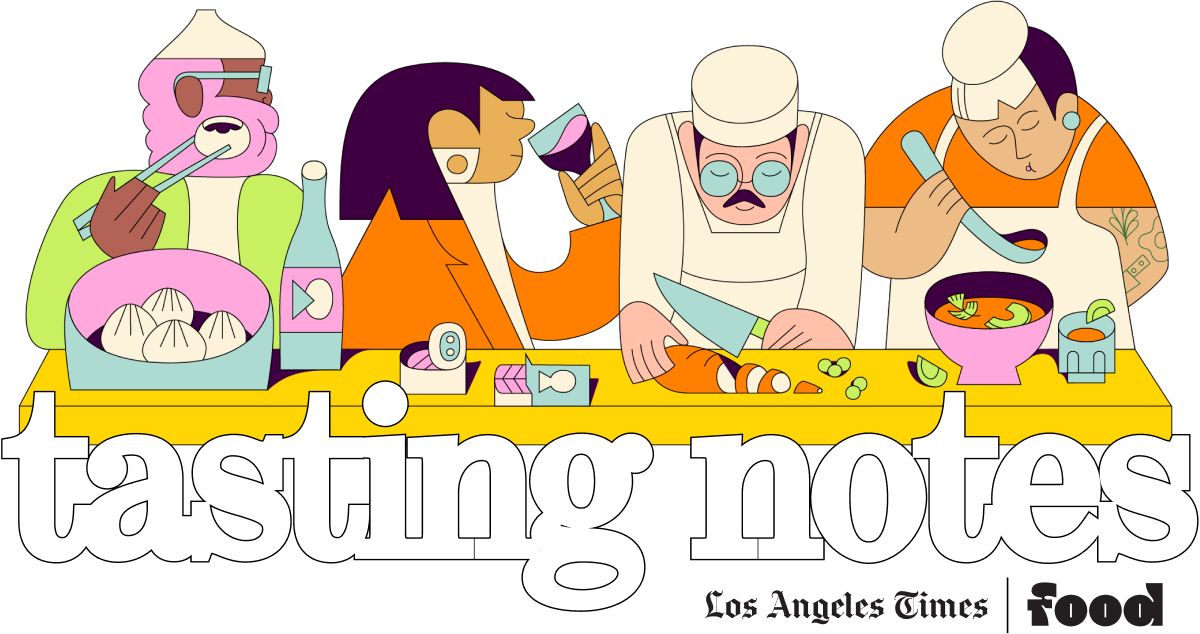What this tiny restaurant in Australia reveals about L.A.’s Korean dining scene

- Share via
At the end of a nearly two-week trip to Melbourne, Australia, early last month, I drove with a friend 50 miles outside the city to a rural town with the amazing name of Cockatoo.
A once-in-a-lifetime Korean meal in Australia
She teetered her pickup truck at the edge of a steep driveway, double-checking the address to make sure we were in the right place. She inched her way down to park and we walked the short path to a house nestled in the woods. Yoora Yoon greeted us at the door and welcomed us inside. We had made it to our Saturday lunch destination: Chae, a six-seat restaurant centered on the talents of Jung Eun Chae, to whom Yoon is married.
Yoon stood at the crook of the L-shaped counter where the diners had settled and introduced Chae as she quietly glided between tasks in the open kitchen we sat facing. Then he left the room. Chae placed pots of ginseng tea on burners in front of us. We were in her hands.

A trio of bites comprised the first of seven courses. Sanjeok can refer to skewered meats and vegetables; Chae reconceived the dish as minced chicken marinated in ganjang (the Korean version of soy sauce that Chae makes herself) and pan-fried. She hid a lightly candied walnut half in its center for crunch. It was flanked by two jeon, or fritters. One was a loose ball of shrimp and julienned king oyster mushrooms nipped with spring onion and chile, flattened where it had browned in the skillet. The other was a zucchini coin cooked in translucent egg batter.
Each was a microcosm of mixed textures and savory flavors. I looked over with “ok, wow” raised eyebrows at the friend next to me, Besha Rodell. Longtime food-obsessed Angelenos will remember Besha as the last food critic for L.A. Weekly, from 2012 to 2017. She’s currently the chief restaurant critic for the Age and Good Weekend in Melbourne, and this month her memoir “Hunger Like A Thirst” was published.
We’ve been close for 20 years and shared many exceptional meals. Chae was shaping up to be one of them.

A stone bowl filled with more diverse tastes arrived next. Pyeonyuk, striated pork meat and fat pressed into square slices for satisfying chew. Yukhoe, a tangle of chopped raw beef glossed with just-made sesame oil. The dish often includes Asian pear; Chae spritzed it instead with a fermented apple extract she had concocted. Cilantro leaves dressed in nutty perilla oil acted as mulchy contrast against poached octopus and a ojingeo-jeot, squiggly fermented squid.
In the center of the plate, to season and balance the tastes, was a dense pool of cho-gochujang, a vinegared variation on the ubiquitous Korean chile paste. Chae had made this, too, from the very building blocks of Korean cuisine: She ferments her own meju, the bricks of crushed soybeans also used to craft ganjang and doenjang, the paste analogous to miso.

I’m generally a fast eater. This collage of small dishes, where every element felt so considered, managed to slow me way down.
Something beautifully simple followed: chicken noodle soup, its poultry-intense broth sharpened only by thin triangles of radish kimchi.
Chae, who was born in Seoul, had been working in Melbourne fine dining when she injured her ankle in a motorcycle accident, forcing her to step away from the extreme demands of kitchen work. She was considering her next move when she watched the season-three episode of “Chef’s Table” on Netflix about Buddhist nun-chef Jeong Kwan, who lives and teaches at the Baegyangsa temple in South Korea. Moved by the clarity of her philosophy and relationship to nature, Chae went to study with her. It set the path for her tiny home-based restaurant, where she would make her own jangs — as she remembered her mother doing in her childhood — and serve meals only two days a week.
What we have (and don’t have) in Los Angeles
I read up on all this after my meal with Besha, but aspects of the cooking registered as familiar even in the moment.
Kwang Uh, the chef and co-owner of extraordinary Baroo in Los Angeles, also studied with Jeong Kwan; he met his wife and business partner Mina Park at the temple. With a couple of day’s notice, Uh will make a vegetarian or vegan version of Baroo’s set menu. When I think of its bowls of wondrous, seaweed-seasoned rice and banchan of seasonal vegetables, and treasures like dried acorn jelly with the thick chew of cavatelli, I can trace the through-line of Jeong Kwan’s influence to both chefs. I’m remembering Chae’s finale of rice crowned with spinach and mushrooms and sides of kimchi and spicy radish salad; she served it alongside jeongol (hot pot) of mushrooms and croquettes of minced beef and tofu.
Los Angeles, we all know, is blessed with one of the world’s great Korean dining cultures. If I’m hungry for jeon of many shapes, I can head to HanEuem in Koreatown. For soup that seemingly heals all ills, we have Hangari Kalguksu. For chefs that turn the essence of Korean cuisine into personal, meditative tasting menus, we have Uh at Baroo and Ki Kim at his new Restaurant Ki.
And still: How rich to have a meal, on the opposite side of the world, that expressed another side of the culinary Korean diaspora unlike anything I’ve experienced. The economics of a small operation like Chae‘s must sometimes feel precarious. But the impressive structure and flow of the meal, balanced with a forested home environment in a room full of honeycomb-colored woods, was singular. Would a chef anywhere in the Los Angeles area be able to age meju, produce their own jangs and serve meditative meals to a tiny number of people?
Unlikely, but if nothing else, it reminds me that the Korean dining possibilities here are inexhaustible.

You’re reading Tasting Notes
Our L.A. Times restaurant experts share insights and off-the-cuff takes on where they’re eating right now.
You may occasionally receive promotional content from the Los Angeles Times.
Curtis Stone’s Malibu work retreat
I’ll be writing more in detail about my time eating in and around Melbourne in the coming months. Australia is on our minds at the Food section this weekend since the Times and Tourism Australia will present the 2nd Annual Great Australian Bite on Saturday, featuring chefs Curtis Stone of Gwen and Pie Room and Clare Falzon visiting from Staġuni above Adelaide in South Australia. The event has sold out, but food reporter Stephanie Breijo wrote about the Malibu property where Stone will host the event — and where he’s building a new lifestyle empire.

Sign up for our Cooking newsletter
Also ...
- My colleagues in the Food section fanned out across Los Angeles to name landmark restaurants in Los Angeles, founded in 1935 or earlier, worth visiting for the meals and the history.
- In a similar spirit, they also name restaurants they’ve loved that are gone but not forgotten.
- Daniel Miller writes about the farmer who is fighting to save the California avocado, challenged by drought and a host of other agricultural and economic issues.
- Stephanie Breijo follows up on the details behind the health department’s sudden closing of sandwich legend Bay Cities Italian Deli.
- Erick Galindo has a guide to 10 great mariscos stops for Sinaloan-style aguachile in L.A.
Eat your way across L.A.
Like what you're reading? Sign up to get it in your inbox every week.
You may occasionally receive promotional content from the Los Angeles Times.

Eat your way across L.A.
Get our weekly Tasting Notes newsletter for reviews, news and more.
You may occasionally receive promotional content from the Los Angeles Times.




